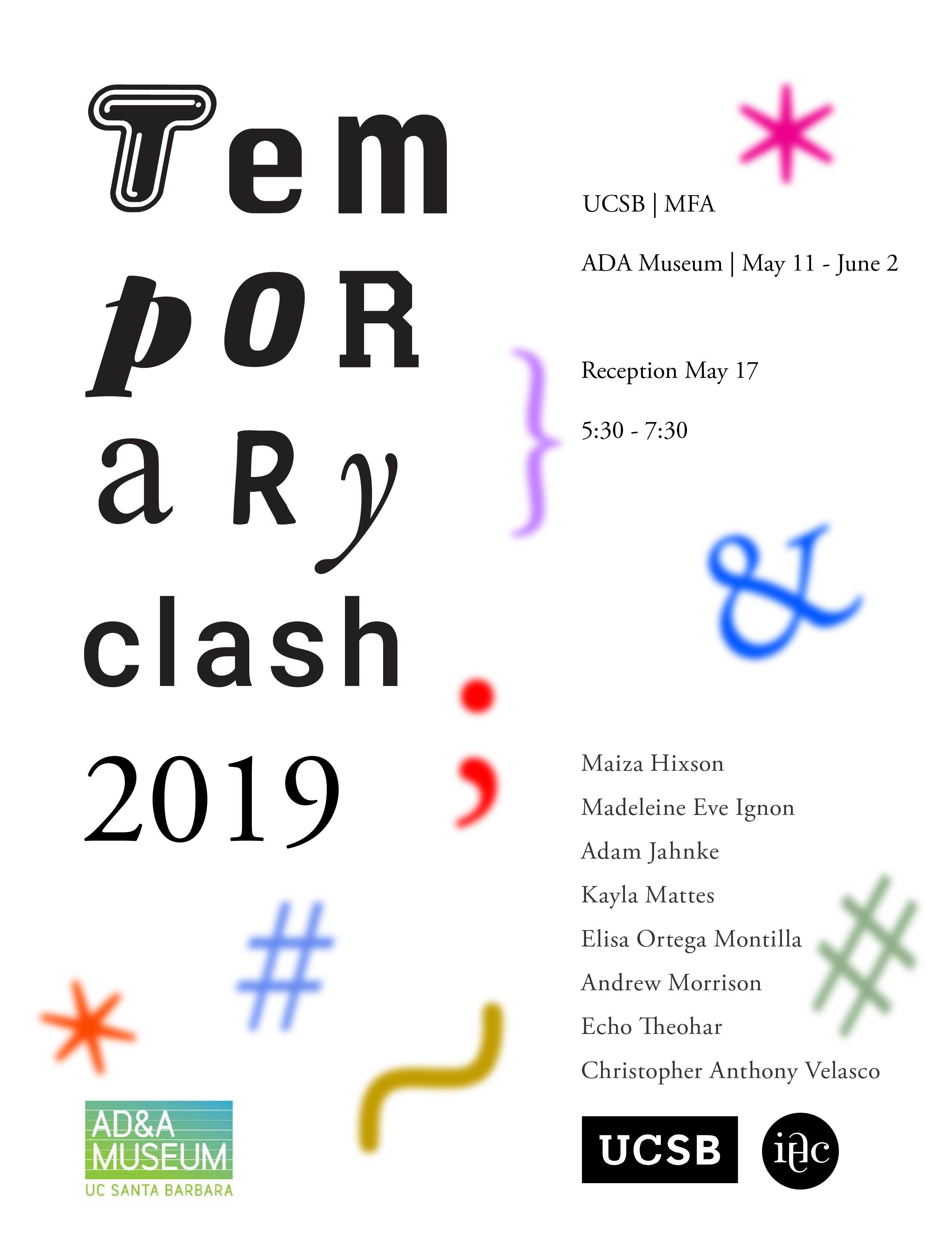TEMPORARY CLASH: UCSB MFA THESIS EXHIBITION
**Events may have been canceled or postponed. Please contact the venue to confirm the event.
Date & Time
Fri, May 17 5:30 PM - 7:30 PM
Address (map)
552 University Rd, Santa Barbara, California 93106
The Department of Art is pleased to present the 2019 MFA thesis exhibition entitled Temporary Clash at the Art, Design and Architecture Museum, UC, Santa Barbara.
The exhibition will be on view from May 11-June 2, 2019.
A reception will be held on Friday, May 17, 5:30-7:30 pm at the AD&A Museum on the campus of UCSB. The exhibition is free and open to the public. The Museum is located at 552 University Rd, Santa Barbara, CA 93106 and is open from Wednesdays-Sundays, 12-5 pm.
These eight young artists—whose enigmatic works are exhibited at the AD&A museum—have developed individual projects that collectively incorporate a broad range of materials, aesthetics, and methods. From discrete objects that transcend their mundane origins to paintings, photography, data programming projections, and weavings they present an array of idiosyncratic sensibilities. These different approaches simultaneously accentuate each other’s singular voices whilst harmonizing as a whole.
Echo Theohar creates compelling computer-generated images and texts that investigate the ways in which visualized data, computer graphics, and programming shape social, cultural and political discourse. Large scale animated projections with superimposed texts that mutate and multiply provide endless new juxtapositions for the viewer to try to decipher.
Seemingly in dialogue with Echo’s work, due to their text-based digital underpinnings, Kayla Mattes’ focus on political activism through screen-based texts and digital messaging are more formally and politically distinct. Her method of weaving exquisite tapestries, and using digital strategies to reflect the rage and anxiety of our current cultural climate creates and contrasts the hand-made craft with the culturally defined content.
Madeleine Ignon, who also utilizes text in her large banner-like paintings yet again distinguishes herself by incorporating a variety of methods in one canvas. With words as image, some clear others barely legible they intertwine in passages of pure abstract paint or subtle representational imagery. One doesn’t know if they are related or just fragments of conflicting narratives in a visual diary, as if scribbled down the morning after a vivid dream.
Andrew Morrison’s work, on the other hand, disrupts any written language motif and explores how a singular visual image can elicit a moment of recognition. His energetically painted images freeze a moment of action such as a depiction of a performance of the San Carlos Apache Tribe of which is a member. By documenting Native American activities on their own terms through regular visits to their reservation he wishes to bring to light his and their experiences within his vibrant community.
Maiza Hixson’s work is a curious combination of multiple forms such as sculptural constructions, paintings, video and performance all inter-connecting conceptually with each other in a playful yet serious reflection of our cultural and political systems. She is Interested in how place and environment influence us and how her multi-faceted work can engage many subjects such as affordable housing, environmental threat through research into Spanish colonial architecture and a feminist critique of wealth and privilege.
Elisa Ortega Montilla explores multiple fundamental aspects of her experiences as a feminist, her Spanish identity and feelings about her acculturation while living in the US, as well as her commitment to environmental sustainability. Utilizing second-hand clothing, wood scraps and old discarded jewelry she cuts, carves, assembles, and ties these elements together to form sensual evocative shapes that allude to the female body whilst transforming and repurposing their materiality.
Adam Jahnke, a mechanic by trade holds an inherent curiosity for architecture and engineering. His interdisciplinary practices guide his artistic gestures towards mechanization, pattern, and repetition. Often initiated by a photograph, the camera serves as a map making tool for his visually engaging installations and sculptures. To Adam his use of photography is ritualistic and like the labor involved in his constructions reflects his studio practice.
Christopher Velasco provides another contrast to the specificity of each artist’s explorations. His emotionally charged, manipulated and defaced polaroid photographs appear to be decaying in front of our eyes. Using cutting, injecting fluids, burning and bleaching he transforms the figurative images into abstractions, layering multiple effects then magnifying them and printing them 40 times larger. The techniques make the images appear to be physically textured even though they are completely flat. Like Trompe l’oeil paintings they both fool the eye while eliciting a palpable, visceral response.

